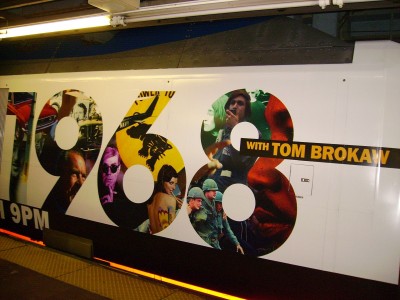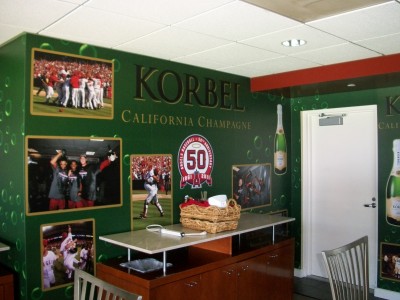Wall graphics
Walls are prime real estate for promotional graphics, yet are often neglected. They can be used for mural-sized advertising, branding and promotion or merely as one part of a retail environment’s visual impact.
Beyond retail spaces, wall graphics are now also being used for special events, corporate facility branding and even barricades during renovations. They are even increasingly being used by consumers to personalize rooms in their homes with colourful imagery.
With these markets in mind, some wall graphic products are permanent for longer-term applications and others are easily removable for short-term promotional campaigns.
Indeed, the options are wide and varied. Metallic films, including silver and gold, can be implemented to make a design shine. Clear films, as with floor graphics, can allow the wall behind them to become part of the design. Self-adhesive fabrics deliver a higher-end esthetic with a woven texture, which might be used to match a product pattern or design in a store, for example.
Wall surfaces also vary, so the selection of adhesive is crucial to a graphic application’s success. A low-tack removable adhesive is ideal for wall borders and small- to medium-format decals. It offers initial repositionability and clean removability for a period of six months or less.
Repositionable ‘microsphere’ adhesives are ideal for small-, medium- and large-format contour-cut decals. They offer clean removability for one year or less.
Finally, high-tack removable adhesives with initial repositionability are ideal for large-format wall murals.
Most films and adhesive systems are designed to adhere well to smooth, non-vinyl wallboards, but whether a wall is smooth or textured, achieving strong adhesion will depend on identifying the surface type first and working with the print media supplier to ensure compatibility. Many vendors will offer application guidelines and technical tips to help ensure each graphic product is a success.
Window graphics
Like walls, windows represent prime real estate for communicating messages and can become an integral part of architectural branding. They can add dramatic impact in isolation or visually transform an entire building.
Windows are readily accessible for the application of graphics, but they have an advantage over walls, in that they provide a smooth surface that is easy to work with when installing and removing films. Hence, they are ideal for seasonal promotions or one-off event branding.
Perforated window films are increasingly being used for one-way graphics, so as not to block people’s view outdoors. They are available in interior-mounted clear and exterior-mounted black and white varieties and in different patterns, including printable-to-open area ratios of 60/40, 70/30 and 50/50. Hole diameters vary from 1.6 to 2 mm (0.06 to 0.08 in.).
There are also super-clear window films that offer a higher-end look for architectural graphics. Industry interest in these materials is also being driven by an increase in zoning restrictions prohibiting signage on buildings’ outside windows.
Some retailers are also turning to 0.15-mm (6-mil) thick clear films with a 70/30 perforation pattern, mounted on the inside surfaces of their windows, to avoid vandalism. Further, a clear film allows more creativity with graphic design, especially in terms of intricate shapes, as there is no need to die-cut the images. And savings are realized because clear perforated films allow for a slight margin of error without the cost of trimming when window measurements are not 100 per cent accurate.
At the other end of the spectrum, thicker-gauge films offer easier installation and two-sided large-format window graphics are a bold answer to advertisers’ promotional needs. In all cases though, it is still a good idea to check in with the media supplier for any technical tips and application guidelines.
As with counter graphics, there is also a trend with window films using new non-vinyl self-adhesive materials for greater environmental sustainability. These products can offer the same performance and esthetic qualities as vinyl films.
White and clear ‘cling’ vinyls intended for interior mounting of graphics offer many advantages, as well. They are low-cost, carry no adhesive (so they can be removed more cleanly) and are reusable if returned to the liner and stored properly. Their printability can be improved and hazing reduced by running them through a dryer set at 38 to 43 C (100 to 110 F) before printing. Clear cling vinyls provide excellent clarity.
There are challenges to consider, however, as cling vinyl has a limited shelf life of 60 days prior to printing and are heavy in plasticizers that can migrate into the printed surface, degrading its ink adhesion and appearance. The liner can also leave an impression on cling vinyl, due to its softness.







